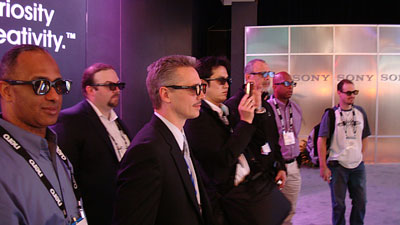3D Delivers at CES 2010

CES attendees check out the 3D at the Sony booth. Photo courtesy Sony Electronics
LAS VEGAS
3D was popping out all over the Las Vegas Convention Center and nearby hotels during the 2010 International Consumer Electronics Show where 2,500 different companies exhibited more than 20,000 new products.
“The whole buzz at CES 2010 was 3D, driven largely by ‘Avatar’ raking in over $1 billion in its first month of release,” said Scott Birnbaum, vice president of LCD Business at Samsung. “This is the year the display hardware is ready to provide consumers with a true 3D experience in the home, and now we are starting to see companies lining up to initiate regular delivery of 3D programming through a variety of channels.”
But is the recession-buffeted public ready for the 3D revolution? LG has already announced plans to ship as many as 400,000 3D-capable TV units in 2010 and Goldman Sachs is predicting 4.3 million 3DTV’s will be sold in 2010, representing 25 percent of all sales.
CONNECTIONS
Connecting a new 3DTV will be easier than ever thanks to the release of the HDMI 1.4 spec last June to accommodate 3D cabling in home theater; and it was a major enabling technology at the 2010 CES. “Version 1.4 includes input/output protocols for 3D, an Ethernet channel, and even support for 4K resolutions,” said Steve Venuti, president of HDMI Licensing, LLC the agent responsible for licensing the standard. “This will help push 3D into the marketplace in a consistent way so that delivering 3D to the devices from all our over 850 HDMI adopters will no longer be a proprietary consideration.”
There is also a growing demand for a wireless connectivity option, and one of the CES Innovations 2010 Design and Engineering Award honorees was Santa Clara, Calif.-based chipmaker Amimon, which founded the WHDI (Wireless Home Digital Interface) Consortium promoted by Sony, Samsung, Sharp, Motorola, Hitachi and LG. “The goal of WHDI is to connect any source in the home to any display,” said Noam Geri, vice president of marketing and co-founder of Amimon. “Using the 5GHz unlicensed band, WHDI can deliver 1080p quality to game or entertainment systems without wires or latency.”
THE CONTENT
Traditionally, many have questioned where all this 3D content will come from, but the impact of the Blu-ray Disc Association announcing their final 3D specification in December was seen on many displays in the Las Vegas Convention Center as the BDA starts enabling studios to market 3D discs to home viewers.
In addition, several content providers plan to begin making 3D programming available to the American public in 2010. The first to deliver may be Next3D whose broadband, Web-based 1080p 3D HD Video-on-Demand Internet service will begin operation in the first quarter of 2010 in collaboration with Turner Broadcasting System. “This will include 3D features and documentaries, sports, TV journalism, and user-created material,” said Next3D Co-founder David Cole. “We should start real time streaming during selected windows of time starting in March, and subscribers will be able to download the content to watch at their leisure.”
ESPN announced it will present 85 sporting events in 3D this year, starting with the 2010 FIFA World Cup match on June 11. “This decision was made with one motivation only,” said Chuck Pagano executive vice presdient of technology at ESPN in Bristol, Conn. “Our viewers are going to be buying 3DTV’s since sports fans have been proven to be early adopters. We need to provide them with content to watch.”
Later this year, Discovery Communications Inc., Sony Corp. and IMAX Corp. plan to develop the first U.S. television network dedicated to 24/7 3D programming.
“Clearly the next Christmas season will be a big push for us,” said John Honeycutt, Discovery’s chief media tech officer. “At first we will be using one of the side-by-side configured 3D methodologies so we can use existing HD resolution bandwidth, but we have no interest in format battles. Our ultimate goal will be whatever the consumer demands.”
Although unnamed at present, this Discovery/Sony/IMAX venture will not have a shadowed 2D channel. But as Honeycutt said, “The great thing about the 3D production process is that anything we create is exploitable in 2D on other outlets.”
One question remains, however. With all the glasses-free or “autostereoscopic” 3D displays at 2010 incapable of rising above resolutions fit for digital signage applications, will home consumers be willing to accept wearing special glasses to watch stereoscopic 3D in their living rooms?
“There are going to be bumps in the road, of course,” said Chris Chinnock, president of Insight Media and board member of the 3D @ Home Consortium. “3D in home theater also involves many human factors and they will have to be dealt with.”
Get the TV Tech Newsletter
The professional video industry's #1 source for news, trends and product and tech information. Sign up below.
